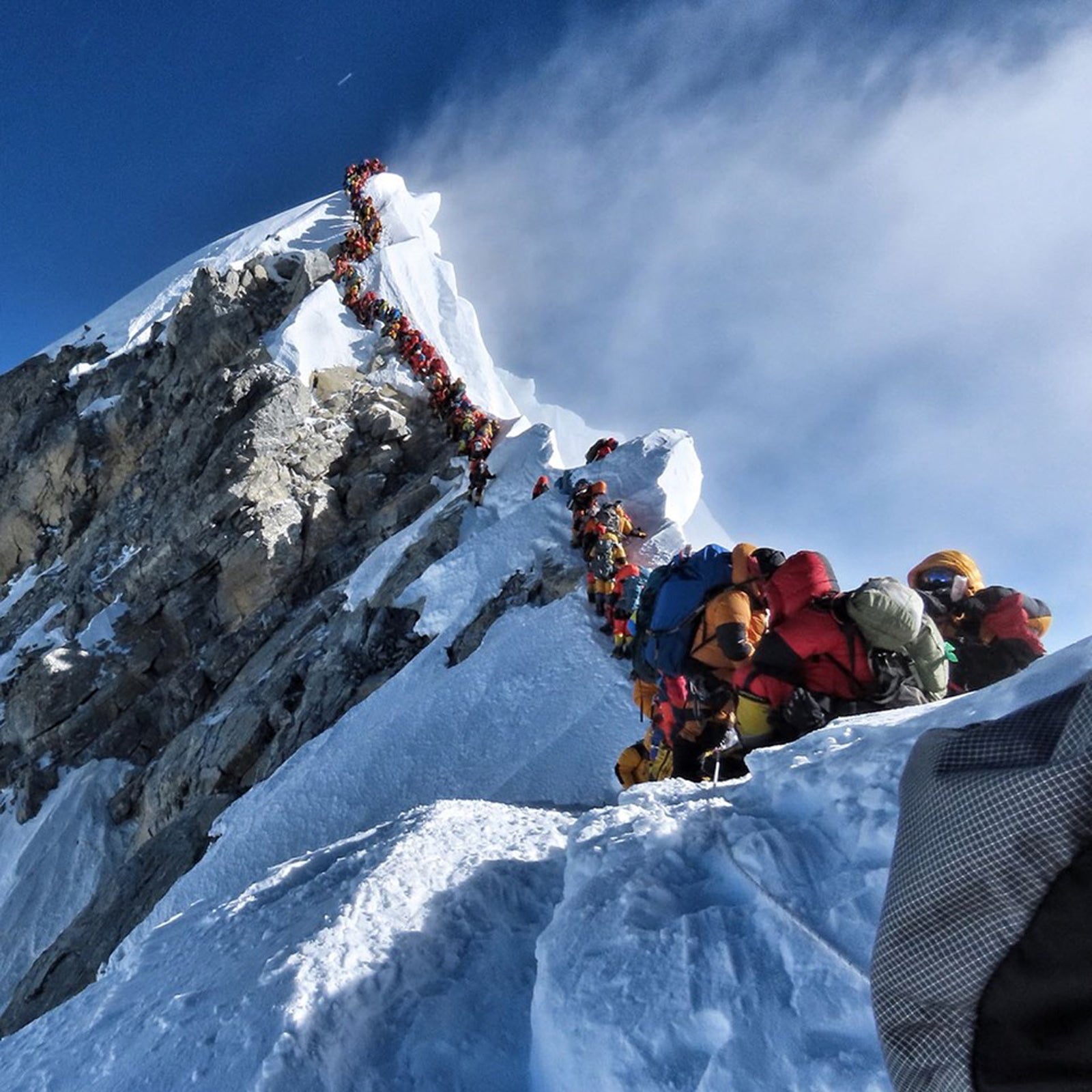The 2021 Mount Everest climbing season will soon be underway, after a hiatus last year due to the COVID-19 pandemic. By the end of March, Everest Base Camp in Nepal will once again be teeming with activity as expeditions settle in on the Khumbu Glacier, where they’ll spend several weeks making acclimatization rounds up and down the mountain before their final summit pushes in May. As usual, no one is allowed on the south side of the mountain without a permit from the Nepalese government, but this year the government has declared , including one that’s particularly baffling: individuals may not take or share photographs of other climbers on the mountain without its permission.
Mira Acharya, the mountaineering director at Nepal’s Department of Tourism, , “Each climber can take, share, and make images and videos of their group or of oneself, but they will face action if they take, make, and share photos of other climbers without the department’s consent.” Acharya also clarified that it’s always been against the law for Everest climbers to share photos of other Everest climbers without the government’s consent, but that this year the Department of Tourism intends to crack down on the practice.
It’s not clear what sort of punishment or fine the government will impose on people who take photos without permission. It’s even less clear how the government intends to enforce the rule, given how easy it is for anyone with a cell phone and an internet connection to discreetly and instantaneously take and share photos. But the motivation behind it is easy to guess: Nepal presumably wants to avoid another news cycle like the one triggered by Nirmal Purja’s viral photo of a line of climbers on Everest’s summit ridge in 2019. (Nepal’s Department of Tourism did not respond to �����ԹϺ���’s request for comment on the photo ban.)
The new rule is about “control,” says Greg Vernovage, an guide who’s led expeditions on Everest for more than ten years. “I would say Nepal wants control over as much of the press as they can. I’ve been asked many times about that now famous picture from the South Summit—people have asked, ‘Greg, is this true?’ And you know, pictures don’t lie. And yes, that was true.”
That photo ricocheted around the world within days, sparking a controversy that was covered by every major media outlet, including , which published four different stories featuring the picture, calling for Nepal to take action to limit traffic on the mountain. A consensus quickly emerged in the Western media: Everest had simply become too crowded, with too many inexperienced guides accompanied by too many inexperienced clients, and a lack of oversight by Nepal’s authorities was partly to blame.
“They need to be reevaluating what is important, not only to the country but all the expeditions that are paying to be on the mountain.”
After the 2019 season, which was also marked by at least 11 deaths, Nepal announced new Everest regulations: guiding companies would only receive permits if they had a minimum of three years of experience organizing high-altitude climbing expeditions, and individuals had to prove that they had climbed at least one peak more than 21,000 feet before. “While a step in the right direction, the two major rules can be easily bypassed and lack teeth,” Alan Arnette wrote in �����ԹϺ��� when they were announced.
Many of Nepal’s regulations on Everest could be described that same way. (Everest can also be climbed in China, where the laws and operating standards are different.) A long-standing one requires expeditions to remove all of their trash from the mountain or face fines, but “this has never been enforced,” says Arnette, who has climbed on the Nepal side of Everest four times and keeps in contact with a wide network of guides on the mountain each spring. (Arnette is a regular contributor �ٴ��������ԹϺ���’s Everest coverage.) The main rules that are enforced each year surround the permits and paperwork that guiding companies have to file and pay for in Kathmandu, including an $11,000-per-person permit for climbing on Everest itself (this is for international climbers only; Nepali climbers pay $700 each).
This year in Kathmandu, the Department of Tourism will presumably also be reviewing paperwork attesting �ٴ���post-2019 rules detailing the amount of experience guiding companies and climbers need to be on the mountain. Since there was no climbing on the south side of Everest in 2020 due to the coronavirus, this will be the first season those regulations will be in place. “I certainly hope this year, and every year going forward, people are prepared to climb the mountain,” says Vernovage. “In terms of the rule with the 6,500-meter peak previously climbed—they were talking about instilling that rule for years. It will have to be determined if they enforce it.”
And when it comes to the new restriction on photographs, Vernovage believes that “if they have time to enforce that rule, they need to be reevaluating what is important, not only to the country but all the expeditions that are paying to be on the mountain.”
“I use photos as safety tools,” he adds, noting that his team has decided on routes up the Lhotse Face and through the Khumbu Icefall based on images of those areas—and that often those photos have climbers in them.
Furthermore, Vernovage points out that in order for anyone to receive an official government certificate saying they summited Everest—a practice that’s only been in place for the past decade—they have to show the Department of Tourism a photo of themselves on the summit. But hardly anyone gets that summit moment alone: “I could send you at least 20 to 30 photos of people who have summited Mount Everest with IMG, and there happens to be other people they don’t know in the background,” Vernovage says.
Nepal to complete a weeklong quarantine and submit proof of a negative COVID-19 test, but it is not limiting the number of Everest permits it’s granting this year due to the pandemic. Several expedition companies have, however, rather than bear the coronavirus-associated risks. That means it may be slightly easier to avoid crowds on the summit. Still, bottlenecks in the Khumbu Icefall and different teams clustering together at higher camps on the mountain remain an inevitability, and whether the government can prevent pictures of those scenes from being shared publicly seems unlikely.


